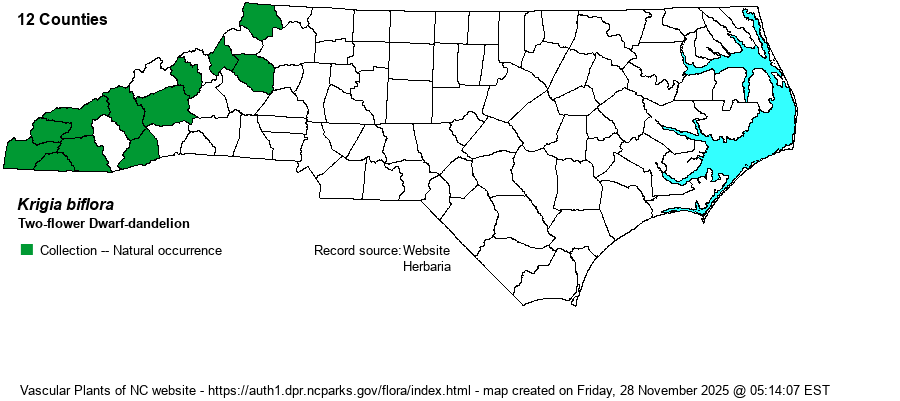| Author | (Walter) S.F. Blake | |
| Distribution | Mountains only. Specimens at NCU from Chatham County, determined as biflora, actually are K. caespitosa.
MA (where adventive) to southern Ont. and MN, south to GA, AR, and OK. | |
| Abundance | Rare to uncommon, and somewhat local. Collections from just 12 counties. This is a Watch List species. | |
| Habitat | Mesic soil of deciduous hardwood forests and pine-hardwood forests; occasionally in openings and clearings. Occurs in somewhat more mesic and more shaded forests than do the other Krigia species. | |
| Phenology | Flowering and fruiting late May to early July (RAB 1968). | |
| Identification | Dwarf-dandelions look superficially like Common Dandelion (Taraxacum officinale), in that the heads have only ray florets. The leaves, however, are not raggedly cut. Two-flower Dwarf-dandelion grows up to 2 feet tall, has relatively large heads that are orange-yellow, and elliptical basal leaves up to 5 inches long. Stem leaves are greatly reduced in size, sessile, and their bases clasp the stem. It is similar to Mountain Dwarf-dandelion (K. montana), but that plant's basal leaves are half as wide (less than 12 mm wide vs. more than 15 mm), and it typically grows in cracks in rocks or along rocky stream banks. Despite the common name, it usually has 3-5 heads, rather than just 2; however, the other strictly montane species (K. montana) has solitary flowers. | |
| Taxonomic Comments | The taxon found in the state is the nominate subspecies.
| |
| Other Common Name(s) | Two-flowered Cynthia, Twin-flowered Cynthia, Orange Dwarf-dandelion | |
| State Rank | S2 | |
| Global Rank | G5 | |
| State Status | [W7] | |
| US Status | | |
| USACE-agcp | FACU link |
| USACE-emp | FACU link |

